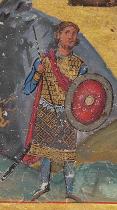
pp.4-5, An Imperial Guardsman of c. AD 1000. The klivanion corselet is gilded. The skirt of the roukhon tunic is grey embroidered with gold crosses, and the gold-patterned border shows flower motifs; the narrow sleeves are light blue with gold dots. The chlamys cloak is red, the trousers (anaxyrida) are in light blue and light yellow, and the sash is in silver. The spearshaft is gold and black; the small cheiroskoutarion shield is scarlet with white ornaments, a silver rim and a gold boss. For a reconstruction, see Plate H2. (Menologion of Basil II, folio 215, Biblioteca Apostolica Vaticana, Rome)
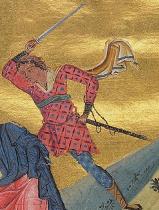
p.9, The Martyrdom of St Euphrasia – detail from an image of c. AD 1000. The man’s light red garment, bearing a rhomboidal pattern in brown, is a clear example of ‘soft armour’ – the padded nevrikon. Centred in each rhomboid is a light blue dot (rivet?), silvered in the middle. The sleeves are of the removable sort, here attached with buttons at the shoulders; the cuffs are embroidered in black and gold. The sash is green, the cloak light yellow with a light blue border. The light blue trousers are chequered and embroidered with yellow flowers, and are tucked into boots which are shown as gold. The scabbard is black with yellow fittings, and the baldric is black. (Menologion of Basil II, folio 333 detail, Biblioteca Apostolica Vaticana, Rome)
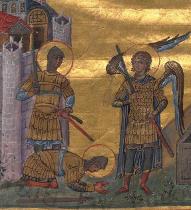
pp.10-11, Joshua and the Angel, in a miniature from an illuminated manuscript of c. AD 1000 that clearly shows the appearance of superior commanders of the Imperial Tághmata. Joshua (left) has a gilded ringmail lôrikion, well fitted to the body by means of a brown leather harness, worn over a gilded zoupa; his scabbard is scarlet with a gold chape. His shining helmet, of pointed outline, is shown in silver and light blue, and is fitted with a leather peritrachelion neck-guard. He wears a light blue tunic with white embroidery, and green anaxyrides with a silver netted pattern. The kneeling general wears a purple-violet chiton with gold dots, and gold-embroidered red trousers; his boots are painted in silver. St Michael (right) has a gilded klivanion; his purple-violet tunic and light blue cloak are both gold-embroidered; his green anaxyrides are embroidered with silver thread, and his red boots are decorated in silver. Note the light blue ribbon (vitta) around his head, bearing a central red stone. The scabbard and baldric are scarlet with gold fittings. (Menologion of Basil II, folio 3)
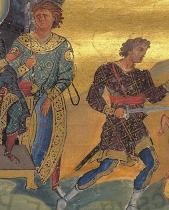
p.11, The Massacre of the Innocents, in an image of c. AD 1,000. The most interesting figure in this New Testament scene is the young royal guard (centre). His tunic is light green, embroidered with small circlets and squared spaces, and with heavy embroidery in gold around the neck and wrists and on the shoulders. The surface of the shield is light blue with red decorations and gold fittings. The model for this guardsman might have been an Imperial Eskoubitor of the Tághmata, since that regiment was linked to the ‘Greens’ faction of the Circus (Hippodrome) in Constantinople. (Menologion of Basil II, folio 281, Biblioteca Apostolica Vaticana, Rome)
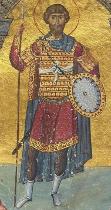
p.14, St Theodore Stratilates was the patron saint of the Athanatoi Tághma, whose appearance may have been the model for this representation of the saint. (This image was probably carried on the regiment’s main flag.) The little omega on the shield, recalling God’s words ‘I am the Alpha and the Omega’, reflects the conception of the ‘eternal’ life – another possible association with a regiment named ‘the Immortals’. The sleeved roukhon is in purple, decorated with small goldembroidered circlets and quadrates on its surface and with gold-thread cuffs and borders. (Menologion of Basil II, folio 383, Biblioteca Apostolica Vaticana, Rome)
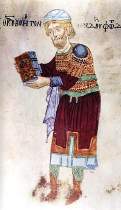
p.16, Iohannes, a Proximos with the court rank of Protospathários, who served under the Dhoux Theodorakan in the Théma of Armenia; for reconstruction, see Plate G1. Note his gilded klivanion with double rivets. The way in which the klivanion was fastened is still difficult to understand, but in this miniature portrait of an Armenian Imperial officer of c. 1007, we note that his corselet is fastened on the shoulders. (Armenian Adrianople Gospel, Mechitarist Library, Venice; author’s photo from original)
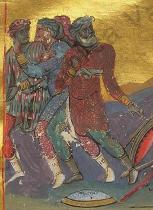
p.18, The Slaying of the Holy Fathers on Sinai. This detail from a miniature of the turn of the 10th/11th centuries shows images of Imperial infantrymen, probably copied from the Constantinople garrison regiments. The headwear is the typical turban or phakeolion, those of alternate figures here being coloured violet-red and dark green. The military tunics are (from left to right) green, red, and white stripes; light blue with gold circlets; and dark red chequered with silver circlets, opening on the right and white-lined. All the embroidery round the cuffs is in gold thread. The trousers are (from left to right) scarlet embroidered in light yellow; violet-red with green-yellow lines and white dots; and green with gold embroidery. The low boots are white and silver. Note also the command sash of the officer in the foreground, probably the pektorarin or loros of the sources. The swords are in silver; the scabbards are black with white fittings, and dark red with yellow fittings. The small cheiroskoutaria shields are in red with a silver rim, and light blue with white dots and gold rim. (Menologion of Basil II, folio 316, Biblioteca Apostolica Vaticana, Rome)
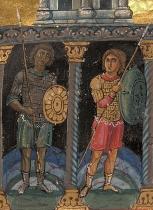
p.21, Warrior of the Méghali Etaireía (Great Etaireía) of the Imperial Guard, recruited from Macedonians and other Christian subjects from the heartlands of the empire; and (right) a ‘marine’ soldier of the Vasilikodhrómonion. Their corselets are silvered and gilded, with white kremasmata on the lower border; the boots are in silver and gold with white dots. Under their armour they wear green and red tunics, one with gold embroidery. The artist has represented both (left) a gilded bronze shield, and the leather shield (dorka) mentioned in De Ceremoniis for the naval troops. The spears are painted in brown and green. (Menologion of Basil II, folio 62 detail, Biblioteca Apostolica Vaticana, Rome)
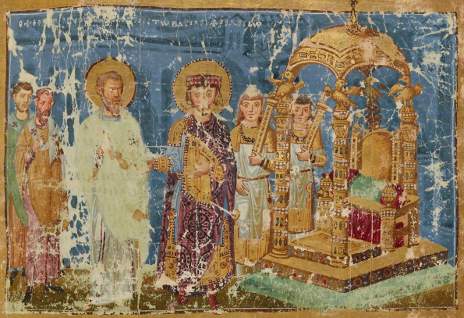
p.23, Sts Gregory of Nazianzius and Theodosius, in a miniature of c. AD 880. The Imperial Spathárioi or Protospathárioi, visible here, were equipped with a spathion chrysokanon, i.e. a sword with a golden hilt, as described in De Ceremoniis (II, 574–575, 640) and the Kletorologion of Philotheos (91, 127) as a distinction of the court rank of these Imperial Guardsmen. (Cod. Par. Gr. 510, folio 239r; ex Kolias)
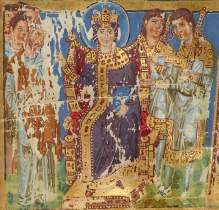
p.27, Constantine and St Helen. This detail from a miniature of c. AD 880 represents the Eunuch Spatharokouvikoulárioi; both they and the Maghlavítai of the Imperial Guard were armed with their gold-hilted spathia during ceremonies and receptions. The former are shown here carrying them over the shoulder, while the latter wore their swords from the belt. (Cod. Par. Gr. 510, folio 440v)
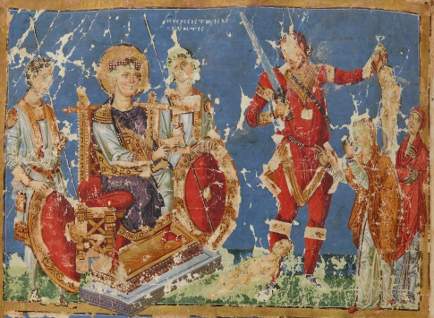
p.30, Detail from The Judgement of Solomon, a miniature of c. AD 880. We may be fairly confident that the model for this image of a guard, holding the infant and awaiting the king’s decision, was a member of the red-uniformed Imperial Maghlavítai. The commander of that corps was the ‘lord high executioner’, who presided over the infliction of corporal punishment, and the death penalty on those judged guilty of treason. For reconstruction, see Plate B1. (Cod. Par. Gr. 510, folio 215v)
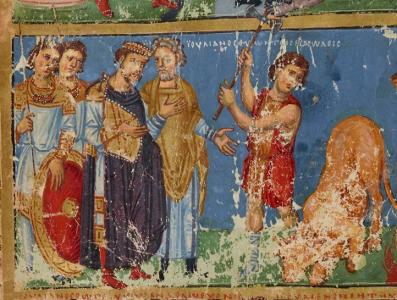
p.31, Detail from miniature, The History of Julian the Apostate, c. AD 880. Note (left) the Imperial Kandidatos in his white uniform, and the three-knot gold maniakion around his neck and falling to his breast. This ceremonial collar is described in the Kletorologion of Phyloteus (90–91) as being worn for the investiture of the Kandidatoi. The shield is painted red with a gold boss and rim. (Cod. Par. Gr. 510, folio 374v; ex Omont)
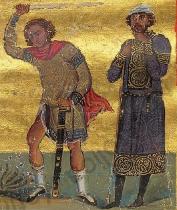
p.33, Martyrdom of St Porphyrius, an image of c. AD 1000. This detail shows an Imperial Strator (right) with his gilded staff (stratorikion), wearing his white phakeolion head-cloth and a colourful skaramangion coat in violet with decorative black, gold and pink-red patterns (compare with Plate B2). His attendant Guardsman (left) wears garments in yellow, gold and scarlet, typical of the magnificent appearance of the Imperial Guard at the time of Basil II. (Menologion of Basil II, folio 159, Biblioteca Apostolica Vaticana, Rome)

p.34, St George dressed in the uniform of an Imperial Guardsman, in a 10th-11th century fresco from a Cappadocian church; compare with Plate B3. (in situ, Church of Aghios Yeorgios, Belisarama; author’s photo)

p.34, Rather more of the lower part of the Imperial Guard uniform survives in this fresco of St Merkourios from the same site. (in situ, Church of Aghios Yeorgios, Belisarama; author’s photo)

p.38, Joshua and his military retinue, in an 11th-century fresco from Kiev; see reconstruction, Plate H3. This may be the earliest known representation of the Varangians in Byzantine service, since it is contemporary with the founder of the regiment, the Emperor Basil II. The officer (archon) in the foreground seems to be wearing leather armour, clearly of Byzantine manufacture.
p.38, (Detail:) the high boot or hypodhémata. The device shown in black seems to have been peculiar to the Varangian Guard, and may be a stylization of the emblem of Kiev, whose ruler first sent them to the Emperor Basil’s aid. (St Sophia Museum, Kiev; author’s photos, courtesy of the Museum)
p.39, Detail from the Joshua fresco, showing (left) the archon’s helmet; it resembles simple Late Roman models, but is worn with a white quilted face and neck-guard. The man on the right, wearing a folded and tied head-cloth, has a red beard – another indication that these are Varangians. (St Sophia Museum, Kiev; author’s photos, courtesy of the Museum)
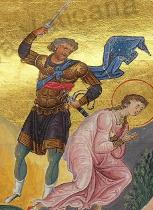
p.55, The Martyrdom of St Barbara, c. AD 1000. The archaic-looking muscled cuirass (thorakion heroikon), and the method of fastening the cloak across the chest, are reconstructed in Plate F2. (Menologion of Basil II, folio 224, Biblioteca Apostolica Vaticana, Rome)
